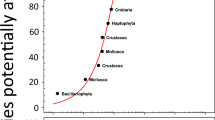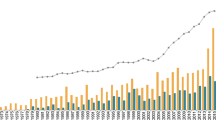Abstract
Purpose
The study develops site-dependent characterization factors (CFs) for marine ecotoxicity of metals emitted to freshwater, taking their passage of the estuary into account. To serve life cycle assessment (LCA) studies where emission location is often unknown, site-generic marine CFs were developed for metal emissions to freshwater and coastal seawater, respectively. The new CFs were applied to calculate endpoint impact scores for the same amount of metal emission to each compartment, to compare the relative ecotoxicity damages in freshwater and marine ecosystems in LCA.
Methods
Site-dependent marine CFs for emission to freshwater were calculated for 64 comparatively independent seas (large marine ecosystems, LMEs). The site-dependent CF was calculated as the product of fate factor (FF), bioavailability factor (BF), and effect factor (EF). USEtox modified with site-dependent parameters was extended with an estuary removal process to calculate FF. BF and EF were taken from Dong et al. Environ Sci Technol 50:269–278 (2016). Site-generic marine CFs were derived from site-dependent marine CFs. Different averaging principles were tested, and the approach representing estuary discharge rate was identified as the best one. Endpoint marine and freshwater metals CFs were developed to calculate endpoint ecotoxicity impact scores.
Results and discussion
Marine ecotoxicity CFs are 1.5 orders of magnitude lower for emission to freshwater than for emission to seawater for Cr, Cu, and Pb, due to notable removal fractions both in freshwater and estuary. For the other metals, the difference is less than half an order of magnitude, mainly due to removal in freshwater. The site-dependent CFs generally vary within two orders of magnitude around the site-generic CF. Compared to USES-LCA 2.0 CFs (egalitarian perspective), the new site-generic marine CFs for emission to seawater are 1–4 orders of magnitude lower except for Pb. The new site-generic marine CFs for emission to freshwater lie within two orders of magnitude difference from USES-LCA 2.0 CFs. The comparative contribution share analysis shows a poor agreement of metal toxicity ranking between both methods.
Conclusions
Accounting for estuary removal particularly influences marine ecotoxicity CFs for emission to freshwater of metals that have a strong tendency to complex-bind to particles. It indicates the importance of including estuary in the characterization modelling when dealing with those metals. The resulting endpoint ecotoxicity impact scores are 1–3 orders of magnitude lower in seawater than in freshwater for most metals except Pb, illustrating the higher sensitivity of freshwater ecosystems to metal emissions, largely due to the higher species density there.




Similar content being viewed by others
References
Aboussouan L, Saft RJ, Schonnenbeck M et al (2004) Declaration of Apeldoorn on LCIA of non-ferro metals. Results of a workshop by a group of LCA specialists, held in Apeldoorn, NL. SETAC Globe 5:46–47
Asmala E, Kaartokallio H, Carstensen J, Thomas DN (2016) Variation in riverine inputs affect dissolved organic matter characteristics throughout the estuarine gradient. Front Mar Sci. doi:10.3389/fmars.2015.00125
Audry S, Blanc G, Schäfer J et al (2007) Budgets of Mn, Cd and Cu in the macrotidal Gironde estuary (SW France). Mar Chem 107:433–448
Barsanti L, Gualtieri P (2014) Algae: Anatomy, Biochemicstry, and Biotechnology, 2nd edition. CSC Press, Pisa
Cai Y, Guo L, Wang X et al (2012) The source and distribution of dissolved and particulate organic matter in the Bay of St. Louis, northern Gulf of Mexico. Estuar Coast Shelf Sci 96:96–104
Campbell PGC (1995) Interactions between trace metals and aquatic organisms : a critique of the free-ion activity model. In: Tessier A, Turner DR (eds) Metal speciation and bioavailability in aquatic systems. Wiley, New York
Cawley KM, Yamashita Y, Maie N, Jaffé R (2014) Using optical properties to quantify fringe mangrove inputs to the Dissolved Organic Matter (DOM) pool in a subtropical estuary. Estuar Coasts 37:399–410
Chester R, Jickells T (2012) The transport of material to the oceans: the fluvial pathway. In: Marine Geochemistry, 3rd edition. Blackwell Publishing Ltd., Chichester, pp 11–51
Cosme N, Mayorga E, Hauschild MZ (2017) Spatially explicit fate factors of waterborne nitrogen emissions at the global scale. Int J Life Cycle Assess. doi:10.1007/s11367-017-1349-0
Diamond ML, Gandhi N, Adams WJ et al (2010) The clearwater consensus: the estimation of metal hazard in fresh water. Int J Life Cycle Assess 15:143–147
Dong Y, Gandhi N, Hauschild MZ (2014) Development of comparative toxicity potentials of 14 cationic metals in freshwater. Chemosphere 112:26–33
Dong Y, Rosenbaum RK, Hauschild MZ (2016) Assessment of metal toxicity in marine ecosystems—comparative toxicity potentials for nine cationic metals in coastal seawater. Environ Sci Technol 50:269–278
Dreyer LC, Niemann AL, Hauschild MZ (2003) Comparison of three different LCIA methods: EDIP97, CML2001 and Eco-indicator 99. Int J Life Cycle Assess 8:191–200
EPRTR (2012) European industrial annual pollutant release. European Environment Agency (EEA), Copenhagen
Gandhi N, Diamond ML, Huijbregts MAJ et al (2011) Implications of considering metal bioavailability in estimates of freshwater ecotoxicity: examination of two case studies. Int J Life Cycle Assess 16:774–787
Gandhi N, Diamond ML, van de Meent D et al (2010) New method for calculating comparative toxicity potential of cationic metals in freshwater: application to copper, nickel, and zinc. Environ Sci Technol 44:5195–5201
Goedkoop M, Heijungs R, Huijbregts M et al (2012) ReCiPe 2008. A life cycle impact assessment method which comprises harmonised category indicators at the midpoint and the endpoint level. First edition (revised) report I: characterisation. Ministry of Housing, Spatial Planning and the Environment, Bilthoven
Goedkoop M, Heijungs R, Huijbregts M et al (2013) ReCiPe 2008: A life cycle impact assessment method which comprises harmonised category indicators at the midpoint and the endoint level
Huijbregts MAJ, Thissen U, Guinée JB et al (2000) Priority assessment of toxic substances in life cycle assessment. Part I: calculation of toxicity potentials for 181 substances with the nested multi-media fate, exposure and effects model USES–LCA. Chemosphere 41:541–573
Jolliet O, Margni M, Charles R et al (2003) IMPACT 2002+: a new life cycle impact assessment methodology. Int J Life Cycle Assess 8:324–330
Jouanneau JM, Latouche C (1982) Estimation of fluxes to the ocean from mega-tidal estuaries under moderate climates and the problems they present. Hydrobiologia 91:23–29
Karageorgis AP, Anagnostou CL (2001) Particulate matter spatial–temporal distribution and associated surface sediment properties: Thermaikos Gulf and Sporades Basin, NW Aegean Sea. Cont Shelf Res 21:2141–2153
Kim TI, Choi BH, Lee SW (2006) Hydrodynamics and sedimentation induced by large-scale coastal developments in the Keum River Estuary, Korea. Estuar Coast Shelf Sci 68:515–528
KTH (2010) Visual MINTEQ ver 3.0. Retrived from: https://vminteq.lwr.kth.se/download/. Accessed 8 Apil 2014
Li Y-H, Burkhardt L, Buchholtz M et al (1984) Partition of radiotracers between suspended particles and seawater. Geochim Cosmochim Acta 48:2011–2019
Liu JP, Xu KH, Li AC et al (2007) Flux and fate of Yangtze River sediment delivered to the East China Sea. Geomorphology 85:208–224
Lykousis V, Chronis G (1989) Mechanisms of sediment transport and deposition: sediment sequences and accumulation during the Holocene on the Thermaikos plateau, the continental slope, and basin (Sporadhes basin), northwestern Aegean Sea, Greece. Mar Geol 87:15–26
Malmgren L, Brydsten L (1992) Sedimentation of river-transported particles in the Öre estuary, northern Sweden. Hydrobiologia 235–236:59–69
Martin JH (1992) Iron as a limiting factor in oceanic productivity. In: Falkowski PG, Woodhead AD (eds) Primary Productivity and Biogeochemical Cycles in the Sea. Springer US, pp 123–137
Mason RP (2013) Trace Metals in Aquatic Systems. Wiley-Blackwell Publishing Ltd., Chichester
Monbet P (2006) Mass balance of lead through a small macrotidal estuary: the Morlaix River estuary (Brittany, France). Mar Chem 98:59–80
Paulson AJ, Feely RA, Curl HC Jr et al (1988) The impact of scavenging on trace metal budgets in Puget Sound. Geochim Cosmochim Acta 52:1765–1779
Pizzol M, Christensen P, Schmidt J, Thomsen M (2011) Eco-toxicological impact of “metals” on the aquatic and terrestrial ecosystem: a comparison between eight different methodologies for Life Cycle Impact Assessment (LCIA). J Clean Prod 19:687–698
Radach G, Gekeler J, Becker G et al (1996) The NOWESP research data base. Dtsch Hydrogr Zeitschrift 48:241–259
Rosenbaum RK, Bachmann TM, Gold LS et al (2008) USEtox-the UNEP-SETAC toxicity model: recommended characterisation factors for human toxicity and freshwater ecotoxicity in life cycle impact assessment. Int J Life Cycle Assess 13:532–546
Salminen R (2005) FOREGS Geochemical Atlas of Europe, Part 1: Background Information, Methodology and Maps. Geological Survey of Finland, Espoo
Sato G, Negassi S, Tahiri AZ (2011) The only elements required by plants that are deficient in seawater are nitrogen, phosphorous and iron. Cytotechnology 63:201–204
Sherman K (1991) The large marine ecosystem concept: research and management strategy for living marine resources. Ecol Appl 1:349–360
Stumm W, Morgan JJ (1996) Aquatic chemistry. Wiley, New York
Sunda W (1989) Trace metal interactions with marine phytoplankton. Biol Oceanogr 6:411–442
Takata H, Aono T, Uchida S (2012) Distributions of trace metals Co, Cu and Cd in northern Sagami Bay, Japan and their relationship to estuarine variables. Estuar Coast Shelf Sci 111:84–94
Tipping E, Lofts S, Sonke JE (2011) Humic Ion-Binding Model VII: a revised parameterisation of cation-binding by humic substances. Environ Chem 8:225–235
Turner A (1996) Trace-metal partitioning in estuaries: importance of salinity and particle concentration. Mar Chem 54:27–39
USEPA (2006) Volunteer estuary monitoring: a methods manual, 2nd edition. USEPA, Washington
USEtox Team (2016) USEtox. Retrieved from http://www.usetox.org/. Acceessed April 2017
van Zelm R, Huijbregts MAJ, van de Meent D (2009) USES-LCA 2.0—a global nested multi-media fate, exposure, and effects model. Int J Life Cycle Assess 14:282–284
Wit F, Müller D, Baum A et al (2015) The impact of disturbed peatlands on river outgassing in Southeast Asia. Nat Commun 6:10155
Zhang J, Wen Huang W, Chong Shi M (1990) Huanghe (Yellow River) and its estuary: sediment origin, transport and deposition. J Hydrol 120:203–223
Acknowledgements
This research is financially supported by the EU commission within FP7 Environment ENV. 2008.3.3.2.1: PROSUITE (Grant agreement No.: 227078). We thank Stylianos Georgiadis (DTU Compute) and Qijiang Ran (Accelink Denmark) for their contributions on the statistical analysis.
Author information
Authors and Affiliations
Corresponding author
Additional information
Responsible editor: Mark Huijbregts
Rights and permissions
About this article
Cite this article
Dong, Y., Rosenbaum, R.K. & Hauschild, M.Z. Metal toxicity characterization factors for marine ecosystems—considering the importance of the estuary for freshwater emissions. Int J Life Cycle Assess 23, 1641–1653 (2018). https://doi.org/10.1007/s11367-017-1376-x
Received:
Accepted:
Published:
Issue Date:
DOI: https://doi.org/10.1007/s11367-017-1376-x




